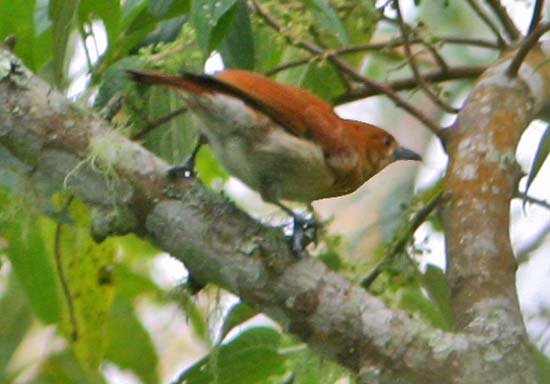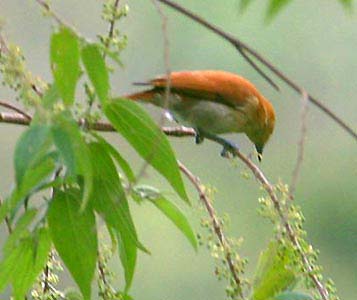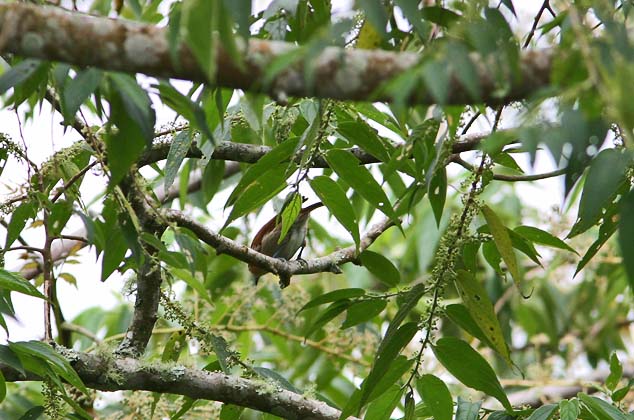
a web page by Don Roberson |
CINNAMON IBON Hypocryptadiidae |
|
Now, an odd "white-eye" in the mountains of the Philippines proves to be a relict sparrow. Cinnamon Ibon (left), an enigmatic bird of the cloud forest canopy on Mindanao, turns out to be evolved from the Old World passerids; Fjeldså et al. (2010). Yet its geographic location is so far distant from an other member of the Passeridae that it "is difficult to explain without assuming an over-water dispersal event" many eons ago; Fjeldså et al. (2010). |
The Handbook of the Birds of the World (van Balen 2008) designated Hypocryptadius as a monotypic subfamily among the White-eyes [Zosteropidae] but noted that the "Cinnamon Ibon is taxonomic oddity whose placement in the Zosteropidae is often questioned, but without convincing alternatives being offered. ... [it is] distinct from the rest of the Zosteropidae, being the only white-eye to lack a deeply bifurcate tongue and the only one to have deep cinnamon plumage. Whereas it is considerably larger than even the second largest white-eye, is has, in contrast, the shortest tarsus. In addition, compared to other zosteropids, its nostril structure is different; it has a far wider and deeper bill; and it lacks an eye-ring." The concluded that "little or nothing is known about its vocalizations and nidification which could provide some clues to its relationships. In the meantime, it is probably best to place it in an old subfamily Hypocrytadiinae, of which it is the sole member, although it may merit placement in a separate family altogether." Fjeldså et al. (2010) provided evidence that this Ibon bird evolved from the evolutionary line that led to today's Passeridae [Old World Sparrows]. They, too, proposed that it "should be retained in a distinct, monotypic subfamily, Hypocrytadiinae." Yet their evidence showed that, "based on our calibration points the Passeridae emerged around 35 Mya [million years ago] and the Cinnamon Ibon diverged from the typical sparrows c. 31 Mya. The radiation of the typical sparrows [Passer, Petronia and Montifringilla occurred later, around 25 Mya." This means that Cinnamon Ibon has been on its own evolutionary path for ~31 million years. Such a divergence time is more similar to clades that we consider Families, rather than Subfamilies. As just one example, the "basal divergences among Old World warblers range from 32.3 Mya between the Spenoeacus clade and remaining warblers to 31.3 Mya between megalurine and other warblers;" Beresford et al. (2005). The Spenoeacus clade mentioned is now widely considered a separate family, the Macrosphenidae [African warblers & crombecs], and the rest of the Old World warblers have been formally broken up into separate families, including the Megaluridae [grassbirds]. If these evolutionary clades are considered Families, having split off from their nearest relatives ~31 to 32 million years ago, it seems logical to me that Hypocryptadius should be treated similarly. This is especially true since it is geographically so far removed from the nearest member of the Passeridae. So, tentatively, I consider the Cinnamon Ibon to be a member of a monotypic family, the Hypocryptadiidae. |
Cinnamon Ibon is a canopy species in mixed foraging flocks, often with Black-masked and Mountain White-eyes, Black-and-cinnamon Fantails, Elegant Tits, and Mountain Leaf-Warbler (Kennedy et al. 2000). A typical view of the bird is looking upward into the canopy (left), although it forages are all forest levels. Kennedy et al. (2000) says that it actively gleans for insects (which is surely true) but in the shot above it appears to be eating small fruits also. Fjeldså et al. (2010) says that its call notes resemble a sparrow; Kennedy et al. (2000) describe them as a "soft, almost whiny whistle." Apparently its nests and eggs are unknown, which means "undescribed in the literature." It is possible that local villagers or visiting birders have unpublished information. Fortunately, it is generally a common species about 1000m elevation in the mountains of southern Mindanao. I've seen several on both trips to Mt. Katanglad, while searching for Philippine Eagle. |
Photos: The photos of Cinnamon Ibon Hypocryptadius cinnamomeus were from Mt. Katanglad, Mindanao, Philippines, on 23 Dec 2005. Photos © Don Roberson; all rights reserved. Bibliographic note: Obviously there is no "family book" about this little-studied bird. It is covered with White-eyes in the HBW series (van Balen 2008) with just a single photo, plus a painting. Literature cited:
|
 A publication in 2010 brought another taxonomic shocker. As background, genetic analysis had revealed that the Donacobius of the Amazon Basin is a relict Old World grassbird; that the Olive Warbler of the American southwest is a relict accentor; and that the "Olive-flanked Whistler" of Sulawesi is a relict bombycillid.
A publication in 2010 brought another taxonomic shocker. As background, genetic analysis had revealed that the Donacobius of the Amazon Basin is a relict Old World grassbird; that the Olive Warbler of the American southwest is a relict accentor; and that the "Olive-flanked Whistler" of Sulawesi is a relict bombycillid.  What used to be called the "Cinnamon White-eye" has long been a mysterious avian. When I first visited the Philippines in 1990 on a tour with Ben King, he had already reached the conclusion this bird was not a white-eye. He coined the name "Ibon" for his genus (Hypocryptadius), and for another genus (Lophozosterops), that he felt were not white-eyes. The word "Ibon," he said, meant "little bird" in a local language. [Later research showed the six Lophozosterops to be white-eyes; only Hypocryptadius has retained the name Ibon.]
What used to be called the "Cinnamon White-eye" has long been a mysterious avian. When I first visited the Philippines in 1990 on a tour with Ben King, he had already reached the conclusion this bird was not a white-eye. He coined the name "Ibon" for his genus (Hypocryptadius), and for another genus (Lophozosterops), that he felt were not white-eyes. The word "Ibon," he said, meant "little bird" in a local language. [Later research showed the six Lophozosterops to be white-eyes; only Hypocryptadius has retained the name Ibon.] 